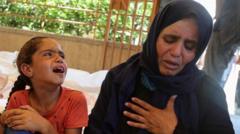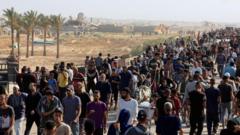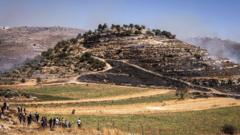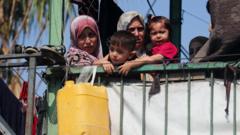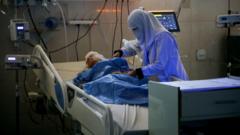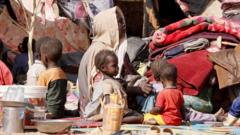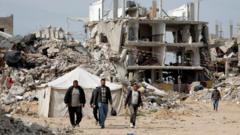An airstrike in central Gaza claimed the lives of ten individuals, including six children, prompting the Israeli military to acknowledge a "technical error." This incident is part of a growing humanitarian crisis, marked by mass casualties and extensive suffering among the civilian population, as international organizations raise alarms about deteriorating conditions.
Rising Casualties in Gaza: Israeli Airstrikes and Humanitarian Crises Persist
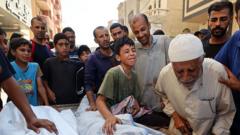
Rising Casualties in Gaza: Israeli Airstrikes and Humanitarian Crises Persist
In the midst of increasing civilian casualties, an Israeli airstrike has reportedly killed children in Gaza, highlighting extensive humanitarian issues and the complexities of military operations.
In a recent escalation of violence, an Israeli airstrike hit a crowded area near a water distribution point in central Gaza, resulting in the deaths of ten people, including six children. Emergency services reported that the bodies of the deceased were transported to al-Awda Hospital in Nuseirat, where 16 others, including seven children, were treated for injuries sustained during the strike. Eyewitnesses recounted a missile fired by a drone striking a queue of people waiting to obtain water, a dire necessity amid the ongoing conflict.
The Israeli military has expressed regret, attributing the incident to a "technical error" intended to target an Islamic Jihad member. They stated that the munitions missed their intended target by several dozen meters. The investigation into the strike's specifics is ongoing. The Israel Defense Forces (IDF) reiterated its commitment to minimizing civilian harm during operations and acknowledged the claims regarding the casualties caused by the airstrike, stressing the importance of collateral damage mitigation.
Footage verified by BBC Verify from the incident shows a chaotic scene with civilians rushing to assist the injured. The camera captured the aftermath, but it couldn’t definitively establish whether the strike involved malfunctioning Israeli weaponry or its point of origin. This incident coincided with a broader pattern of increasing aerial attacks across Gaza.
In a further troubling development, a spokesperson for Gaza's Civil Defense Agency indicated that the day of the airstrike saw 19 other Palestinians killed in various strikes, suggesting a disturbing increase in violence targeting civilians. Concurrently, the International Committee of the Red Cross (ICRC) reported treating significantly more mass casualties in recent weeks compared to prior years, with many injured while attempting to access food distribution sites.
A separate Israeli airstrike on Saturday reportedly killed 24 people near another aid distribution site, with conflicting reports regarding the actions taken by Israeli forces during the event. The IDF denied causing injuries but acknowledged it had fired warning shots.
The UN human rights office has highlighted alarming trends, reporting a total of 789 killings related to aid distribution efforts, with a significant proportion occurring near sites operated by US-backed organizations in military zones. In response, the Gaza Humanitarian Foundation has disputed these claims, defending its operations and stating that many reported casualties cannot solely be attributed to its presence.
Israel’s military operations in Gaza began as a response to the mass casualties resulting from a Hamas attack on October 7, 2023, which left approximately 1,200 individuals dead and led to the capture of another 251. Since then, Gaza has faced severe humanitarian challenges, with at least 57,882 reported deaths and more than 90% of homes damaged or destroyed.
The humanitarian situation has plunged to catastrophic levels, exacerbated by ongoing fuel shortages affecting hospitals, water systems, and sanitation networks. The UN has warned that the recent allowance of a mere 75,000 liters of fuel into the territory is drastically inadequate to meet daily needs, raising concerns that critical services will collapse if conditions do not improve.
The conflict exemplifies a complex interplay of military objectives and civilian realities in Gaza, as challenges to aid delivery and protection of vulnerable populations continue to mount amid persistent violence.



